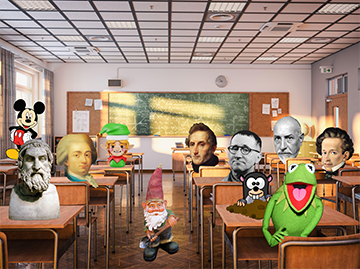“It is a Bible for our contemporary lives: the story of a man who decides to seek clarity by looking within himself”. Thus Stefano Massini explains the elaboration of Freud’s most important work. For the director, Federico Tiezzi, it is “an adventure in thought and language: bearing witness to the exciting and gradual discovery of a method to interpret not only dreams, but the whole world”.
-
Teatro Strehler
“Every era has a couple of books, just a couple, which sum it up completely. To the point in which they become a kind of catalogue. The twentieth century is Freud’s The Interpretation of Dreams. We are children of that book. Thus the necessity and the beauty of dedicating a production of this importance to a work which probably has never been staged” This is how Stefano Massini explains the reasons for an artistic undertaking that led him to adapt Freud’s main work for the stage, interpolating it with other writings. “It is a Bible for our contemporary lives. It is the story of a man who, left alone, decides to seek clarity by looking within himself”. “During the play - explains Massini - Freud analyses dreams, he recalls certain sessions with his patients at the psychiatric clinic or in his Vienna studio, and speaks of his own dreams. But the play of mechanisms, for which everything that in dreams appears disguised and which in reality is profoundly motivated by metaphors, has a wonderfully poetic quality. The way in which these characters - and there are many because our play will have many actors, there is a very substantial cast - are presented to Freud is like a mosaic of different cases and characters, each of which presents an enigma. It is a rich humanity of diverse ages, which leads to accounts which are, in some cases, very lucid and in others profoundly grotesque, which Freud tries to resolve as though they were crime mysteries”.
All of this in a staging which is presented as “an adventure in thought and language”, explains the director Federico Tiezzi. “We witness the exciting and gradual discovery of a method: decrypting the hieroglyphics of dreams to reach an interpretation of reality leads to the discovery of a language which allows us to make sense of the world and of things. This language and this method is created through a journey into the depths of the dreams of many patients. We witness the lucidly impassioned construction of a system to interpret not only dreams, but also the world. Because, as Freud said, dreams are made up of off-cuts of our psyche, not with essential material, not with the important ingredients of our inner self. They are made of material which, upon waking, we don’t even think about. The structure of this piece - explains Tiezzi - is very similar, in its rapidity, to a cinematic screenplay: like in a Hitchcock film, the reader and the spectator want to get to the end, to the discovery, the solution. To the Theatre. Furthermore, in the text there is only one Freud. But I thought that in the play, there could be two of them. This is a piece about mirroring, duplication, about dreams within dreams, a box which contains another box. The protagonist can be divided into two parts: one is reflective, self-analytical: the Freud that writes. The other is a Freud that reacts, who spends time with his patient-characters and interacts with them. These two Freuds argue with each other and Freud’s study is in reality a portal, a suspended world, the threshold between reality and the inner-self”.
Learn more
Booklet
Read“Every era has a couple of books, just a couple, which sum it up completely. To the point in which they become a kind of catalogue. The twentieth century is Freud’s The Interpretation of Dreams. We are children of that book. Thus the necessity and the beauty of dedicating a production of this importance to a work which probably has never been staged” This is how Stefano Massini explains the reasons for an artistic undertaking that led him to adapt Freud’s main work for the stage, interpolating it with other writings. “It is a Bible for our contemporary lives. It is the story of a man who, left alone, decides to seek clarity by looking within himself”. “During the play - explains Massini - Freud analyses dreams, he recalls certain sessions with his patients at the psychiatric clinic or in his Vienna studio, and speaks of his own dreams. But the play of mechanisms, for which everything that in dreams appears disguised and which in reality is profoundly motivated by metaphors, has a wonderfully poetic quality. The way in which these characters - and there are many because our play will have many actors, there is a very substantial cast - are presented to Freud is like a mosaic of different cases and characters, each of which presents an enigma. It is a rich humanity of diverse ages, which leads to accounts which are, in some cases, very lucid and in others profoundly grotesque, which Freud tries to resolve as though they were crime mysteries”.
All of this in a staging which is presented as “an adventure in thought and language”, explains the director Federico Tiezzi. “We witness the exciting and gradual discovery of a method: decrypting the hieroglyphics of dreams to reach an interpretation of reality leads to the discovery of a language which allows us to make sense of the world and of things. This language and this method is created through a journey into the depths of the dreams of many patients. We witness the lucidly impassioned construction of a system to interpret not only dreams, but also the world. Because, as Freud said, dreams are made up of off-cuts of our psyche, not with essential material, not with the important ingredients of our inner self. They are made of material which, upon waking, we don’t even think about. The structure of this piece - explains Tiezzi - is very similar, in its rapidity, to a cinematic screenplay: like in a Hitchcock film, the reader and the spectator want to get to the end, to the discovery, the solution. To the Theatre. Furthermore, in the text there is only one Freud. But I thought that in the play, there could be two of them. This is a piece about mirroring, duplication, about dreams within dreams, a box which contains another box. The protagonist can be divided into two parts: one is reflective, self-analytical: the Freud that writes. The other is a Freud that reacts, who spends time with his patient-characters and interacts with them. These two Freuds argue with each other and Freud’s study is in reality a portal, a suspended world, the threshold between reality and the inner-self”.
Learn more
Booklet
ReadMeetings and insights
Credits
Piccolo Teatro Strehler
dal 23 gennaio all’11 marzo 2018
Freud
o l’interpretazione dei sogni
by Stefano Massini
adapted by Federico Tiezzi e Fabrizio Sinisi
directed by Federico Tiezzi
sets Marco Rossi, costumes Gianluca Sbicca
lighting Gianni Pollini, video Luca Brinchi and Daniele Spanò
movements Raffaella Giordano, vocal preparation Francesca Della Monica
make-up and hair by Aldo Signoretti
with (in alphabetical order) Umberto Ceriani, Nicola Ciaffoni, Marco Foschi, Giovanni Franzoni, Elena Ghiaurov, Fabrizio Gifuni, Alessandra Gigli, Michele Maccagno, David Meden, Valentina Picello, Bruna Rossi, Stefano Scherini, Sandra Toffolatti, Debora Zuin
A Piccolo Teatro di Milano – Teatro d’Europa production
Information and bookings
Telephone service 02.42.41.48.89
From Monday to Saturday 9.45 a.m. – 6.45 p.m.
Sunday 10.00 a.m. – 5.00 p.m.
Teatro Strehler
From Monday to Saturday 9.45 a.m. to 6.45 p.m.
Sunday 1.00 p.m. to 6.30 p.m.
On the evening of the performance the sale of tickets will close one hour before the performance begins.
Groups and organisations
For information on tickets and subscriptions for groups and organisations, and afternoon performances for schools and educational shows, please contact the Servizio Promozione Pubblico e Proposte Culturali.
Tel. 02.72.333.216
e-mail: promozione.pubblico@piccoloteatromilano.it





















